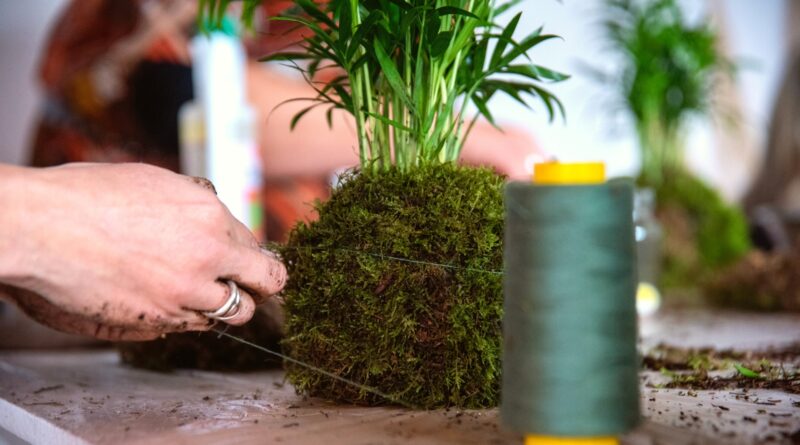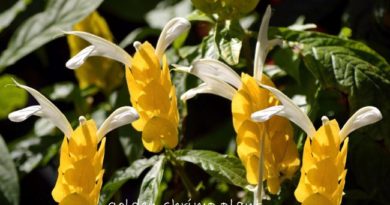How to Make Your Own Kokedama: Japanese Moss Balls
Kokedama is a Japanese term that directly translates to ‘moss ball,’ describing the makeup of these captivating living orbs. It is a form of Japanese art linked to the famous art of bonsai that dates back centuries. You could say keeping a kokedama is like hanging a little piece of history in your garden, although they are just as sought-after in modern gardens as they have been in the past.
Kokedama involves planting a suitable plant in a ball of soil, covering it with moss, and binding it with twine to keep everything in place. The ball is then hung up, as you would hang a basket, or kept in a display bowl either indoors or in shady areas outdoors.
They need plenty of moisture from both watering and humidity, as well as protection from intense sunlight, to stop the moss from burning and the clay soil from drying out too quickly. Although they are most commonly kept indoors, they look just as good hung from the branches of trees outdoors, especially when you use a few filled with different species in the same area.
This unique display method is useful for aesthetic purposes and a great way to save space indoors and out if you don’t want to use hanging baskets. Plus, it’s an easy DIY project that doesn’t require many materials and looks better and better as it grows.
What Plants Can Grow In A Moss Ball?

When you’re making your own moss ball, it’s up to you to decide what to plant in it. It can be tempting to just pick your favorites, but there are a few criteria to consider.
Firstly, moss balls are made from relatively dense clay soil that doesn’t allow much airflow around the roots. You have to choose plants that will be happy in these conditions and aren’t prone to rotting quickly (like succulents).
Lighting is another consideration. Because the ball is covered in moss, it can’t be placed in direct sunlight, or the moss will discolor and die off. Full sun will also cause the soil to dry out too quickly, potentially cracking and becoming difficult to rehydrate. Plants that prefer partial to full shade (like those often grown indoors) are a must-have.
Finally, you need to consider humidity. Kokedamas are healthiest and look their best when hung in high-humidity areas. Tropical plants that are used to high-humidity jungle environments are the ones to look out for, avoiding anything that struggles or experiences high disease rates when air moisture is high.
Given these criteria, it’s easy to see why ferns are usually the first choice for moss balls, thanks to their love of both moisture and shade. But there are plenty of other houseplants that match these needs, including:
What You’ll Need

Once you’ve decided on the plants to grow, you’ll need to grab a few more things before you start:
- Bonsai soil mix
- Coconut coir or peat moss
- Sphagnum moss
- Twine or fishing wire
Equal parts bonsai soil mix and coconut coir or peat moss will usually provide the right soil texture to hold together well. Look for a bonsai mix containing akadama, the clay-like component in the construction of your moss ball. This will help maintain shape and retain water without becoming too heavy.
Sphagnum moss is wrapped around this soil mix to keep everything together. The moss retains moisture, too, but also adds aesthetic value that bare soil doesn’t quite have.
Once you’ve wrapped the ball, you need to keep it all together. This can be done with twine or clear fishing wire – twine if you want the wrap to be visible and fishing wire if you don’t. This is also the material you use to hang up your moss ball when you’re done.
How to Make Your Own Kokedama
When you’re ready to get creative and try this meditative gardening art form, here’s how to get started:
Mix The Soil

The first step in the process involves mixing and moistening the soil in order to mold it successfully. In a bowl, combine equal parts bonsai soil mix and coconut coir or peat moss, adding a bit of water until it holds together but isn’t soggy.
The soil should cling together enough to maintain its shape, but it can’t be too dense. A dense soil will become heavy and suffocate the roots, lacking the drainage required to keep the plants alive long-term. You may need to adjust the ratios as you go, depending on the products you’ve chosen. If you find your soil mix falling apart, add more crushed akadama until it becomes firmer.
If you accidentally add too much water, fill it in with more soil mix or wait for it to dry out a little before you work with it. You don’t want the soil to be falling apart when you’re trying to plant.
Mold The Ball

Gently form a ball that can fit into both hands or larger if you’re working with a bigger plant. Keep in mind that larger balls are heavier and tougher to keep together. It’s better to start small and add more soil later than start with more than you need.
Mold the ball shape and gently press into the top with both thumbs to make a hole large enough for plant roots. It should go all the way to the center of the ball but shouldn’t be so large that the entire thing splits in half. Set it aside to prepare your chosen plant for molding.
Prepare The Plant

Carefully remove your plant from its pot, shaking off excess soil and untangling any compacted roots. Remove as much soil as you can around the root ball, gently teasing the roots apart to avoid damaging them.
You can also use cuttings from existing houseplants that have developed roots in water. These often adapt quicker to kokedama conditions than plants that have been growing in containers and airy soil for a while.
A few roots breaking is not an issue, but you don’t want to damage large sections as this can lead to stress and make adaptation to their new soil slower. If the roots are very long, trim them back slightly to make them easier to fold into your moss ball hole.
Wrap The Roots

Grab the ball you prepared earlier and gently lower the roots into the hole, spreading them out as much as you can. You shouldn’t plant any deeper than the container the plant was in previously, as planting too deep can cause the base of the plant to rot, spreading to the roots and leaves, too.
Carefully close the roots in with soil, squeezing gently to ensure they are evenly covered but not overly compressed. The roots need space to breathe and spread. Make sure you’re satisfied with the overall shape of the ball and the position of the plant before you move on to the next step.
Cover With Moss

Soak your sphagnum moss in water, then squeeze out the excess before wrapping it around the soil ball. If you can find sheets of moss to wrap around the ball, they are usually easier to hold together.
The moss should cover the ball completely and evenly. Avoid patchy areas that make the kokedama look untidy. If you’re struggling to keep everything together, try adding more moisture as you go to help the moss stick.
Secure With Twine

Once the ball is completely covered, get your twine ready to wrap. Wrap gently around the ball so the moss is secured. Don’t pull too tightly, as this can impact the shape of the ball. It shouldn’t be too loose either, or parts of the kokedama may fall apart later on.
Cross the twine around the ball, creating an even pattern. If you’re working with clear wire, you don’t need to worry too much about what the pattern looks like, but you’ll need to be a little more careful with visible twine to stop the ball from looking messy. Continue wrapping until everything holds together without your assistance.
Tie the twine together, leaving a long section at the end to create a loop for hanging. The twine should be strong enough to hold the weight of the ball when the soil is still moist. Hang it from your desired location or place it in a clear bowl and mist continuously to hold everything in place.
Kokedama Care

After you’ve put your creation together, you shouldn’t hang it and forget about it. Regular maintenance is needed to keep the plant happy and the moss looking lush and green.
Watering is the most important task, done by soaking the entire moss ball in water for about 15 minutes and allowing it to drain before hanging or placing it back.
The frequency of watering will depend on your environmental conditions, so keep an eye on the moisture levels by testing the ball’s weight to determine the perfect time to water. You can also mist the ball to keep up with moisture levels if your ambient air is dry.
Every month or two, add a bit of balanced liquid fertilizer to the water while soaking to boost nutrients in the soil. Slow down in fall and winter to give the roots a bit of a break.
Check the moss and twine whenever you water, replacing or repairing as needed to support the plant’s continued growth and health. You will also need to reconstruct the ball every two years or so to improve conditions and provide more space for root growth.
Final Thoughts
Whether you’re looking for a fun garden DIY or want to turn your home into a hanging garden haven, making your own kokedama is ideal.




